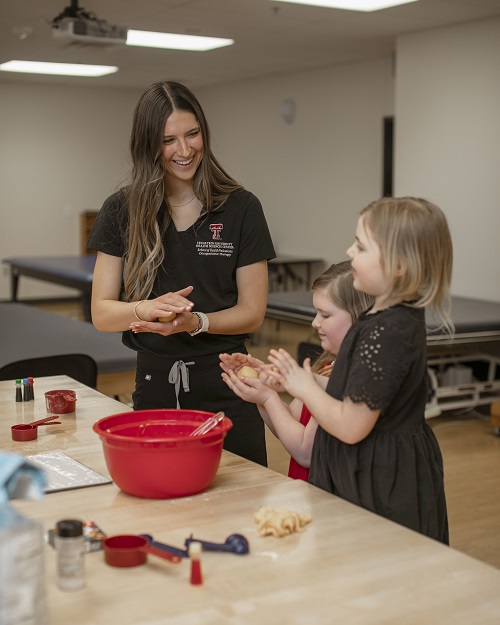Occupational Therapy and Autism Spectrum Disorder
The TTUHSC School of Health Professions Occupational Therapy Doctoral program includes hands-on experiences to prepare students to work with people with autism.

April is World Autism Month and OT Month
April is World Autism Month, created to increase understanding and acceptance of people living with autism and to foster worldwide support. April also happens to be Occupational Therapy (OT) Month (#OTmonth) to celebrate and amplify the enormous service that OTs provide their patients and clients.
Coincidence? We think not.
We spoke with Cindi Tiongco, OTR, Ph.D., to discuss how OTs assess and treat patients with autism, where we are today in our understanding of this often-misunderstood condition, and how TTUHSC is preparing students to improve the lives of those living on the autism spectrum.
Tiongco serves as an Assistant Professor in the Occupational Therapy Program of the TTUHSC School of Health Professions.
Understanding Autism Spectrum Disorder and Neurodivergence

Cindi Tiongco, OTR, Ph.D.
Autism spectrum disorder (ASD) is a developmental disorder that covers a broad range of symptoms, including challenges with social skills, repetitive behaviors, speech and nonverbal communication. The CDC estimates that autism affects 1 in 44 children in the United States.
Tiongco begins by explaining that autism is just one form of neurodivergence. Neurodivergence refers to those whose brains develop or work differently than what is considered typical, or neurotypical.
“We don’t know the causes of autism even now, but have definitely made strides from way before my time,” she says, referring to theories about the causes of autism that range from the use of vaccines to “cold mothering,” a misogynistic theory that arose in the late 40s blaming autism on a lack of maternal warmth.
“We have had really bad ideas about what causes autism,” Tiongco continues. “Now, we have a better understanding that we don’t really know what causes autism, but we do know what it looks like, and we’re better able to identify it and help provide support.”
Person-First and Identity-First Approach to Autism
As we have come to a better understanding of what autism is and isn’t, Tiongco explains that it has opened the door for many new voices, most importantly those who live on the spectrum.
“One of the biggest things that I've had to really think about in my teaching and in my own work, is adults with autism,” she says. “There is a large movement who prefer ‘identity-first’ language, like, ‘I am an autistic teenager’ or ‘I am an autistic person.’”
When it came to persons with disabilities, the Civil Rights Movement amplified person-first language to no longer define people by what they couldn’t do.
Now, with our current understanding of neurodivergence, we are more aware than ever of what individuals with autism can do, and it’s worth celebrating and nurturing. Tiongco says that many in the autistic community are now saying, “I’m not me without my autism.”
Tiongco has noticed a potential dilemma with this development. Her example is a hypothetical example of seeing a patient who identifies with identity-first language (I’m an autistic person), while their parents use person-first language (my child with autism).
“As occupational therapists, what I tell my students is that it comes down to who the person is in front of you. If this child, this adult, this family uses person-first language, then that’s what I’m going to use,” Tiongco says. “If they use identity-first language, then that’s what I’m going to use.”
The Role of the Occupational Therapist In Helping Persons With Autism
A vital component of helping a person with autism achieve their fully-desired potential includes working with an occupational therapist.
“We do a lot of training in sensory processing and sensory integration,” Tiongco says. “One of the biggest ways that OTs help is by identifying the sensory processing differences [in their patients] and helping to change the environment and educate others to help them interact with their environment in a more positive way.”
Sensory integration and sensory processing refer to the way the nervous system receives, processes and responds to sensory input from the external environment. Many people with autism experience processing difficulties, which can result in over- or under-sensitivity to various sensory stimuli, like sounds, textures or smells.
This can lead to avoidance and/or reliance on external stimuli to feel comfortable in one’s environment. Liking or not liking how a stimulus feels is something any person can understand. But imagine if the avoidance or reliance on this sensory input dictated your ability to function. That’s what many with autism experience.
“When you know something is safe and good, that’s what you want,” Tiongco explains. “It can really affect your health and well-being when there’s only certain foods that you can eat.”
Training OT Students to Treat Persons with Autism
The TTUHSC School of Health Professions Occupational Therapy Masters and Doctoral program provides a strong foundation in the clinical reasoning, knowledge and skills necessary to become a highly-qualified occupational therapist, improving the health of individuals and communities.
This foundation includes hands-on experiences that are invaluable in preparing students to work with people with autism. OT students at TTUHSC are exposed to real-life interventions through faculty members, site visits and experiences in the field.
“In the summer, our students participate in different field experiences where they plan and execute different types of interventions,” Tiongco says. “We spend time understanding the diagnosis. How is it diagnosed and what do you do about it?”
By focusing on improving sensory processing, motor skills and social development, occupational therapists help individuals with autism navigate their daily life with greater ease and confidence.
“There are a lot of people who have autism, and we want our students to be sensitive and be the best that they can be when it comes to helping them participate in their daily lives,” says Tiongco.
![]()
Related Stories
TTUHSC School of Nursing Celebrates 10 Years of the Veteran to BSN Program
The TTUHSC School of Nursing recognized the 10-year anniversary of the Veteran to Bachelor of Science in Nursing (VBSN) program during the fall 2025 commencement ceremonies held Dec. 13 in Lubbock, Texas.
Lubbock ISD Middle School Students Become Docs for a Day
Lubbock Independent School District students from Atkins Middle School, McCool Academy and Evans Middle School became doctors for a day as the TTUHSC Student National Medical Association (SNMA) hosted Docs for a Day Nov. 10.
From Classroom to Clinic: Building the Future of Speech-Language Pathology
The Clinical Experience Course in the Speech, Language and Hearing Sciences program at TTUHSC provides students with hands-on, practical application of the theoretical knowledge learned in the classroom.
Recent Stories
Making Mental Health a Priority in the New Year
Sarah Mallard Wakefield, M.D., a psychiatrist with Texas Tech Physicians, talks about strategies to combat widespread and growing anxiety.
TTUHSC Cancer Researcher Honored by National Academy of Inventors
C. Patrick Reynolds, M.D., Ph.D., director of the School of Medicine Pediatric Cancer Research Center at TTUHSC, has dedicated his life as a researcher to developing treatments for childhood cancers.
TTUHSC School of Nursing Celebrates 10 Years of the Veteran to BSN Program
The TTUHSC School of Nursing recognized the 10-year anniversary of the Veteran to Bachelor of Science in Nursing (VBSN) program during the fall 2025 commencement ceremonies held Dec. 13 in Lubbock, Texas.
